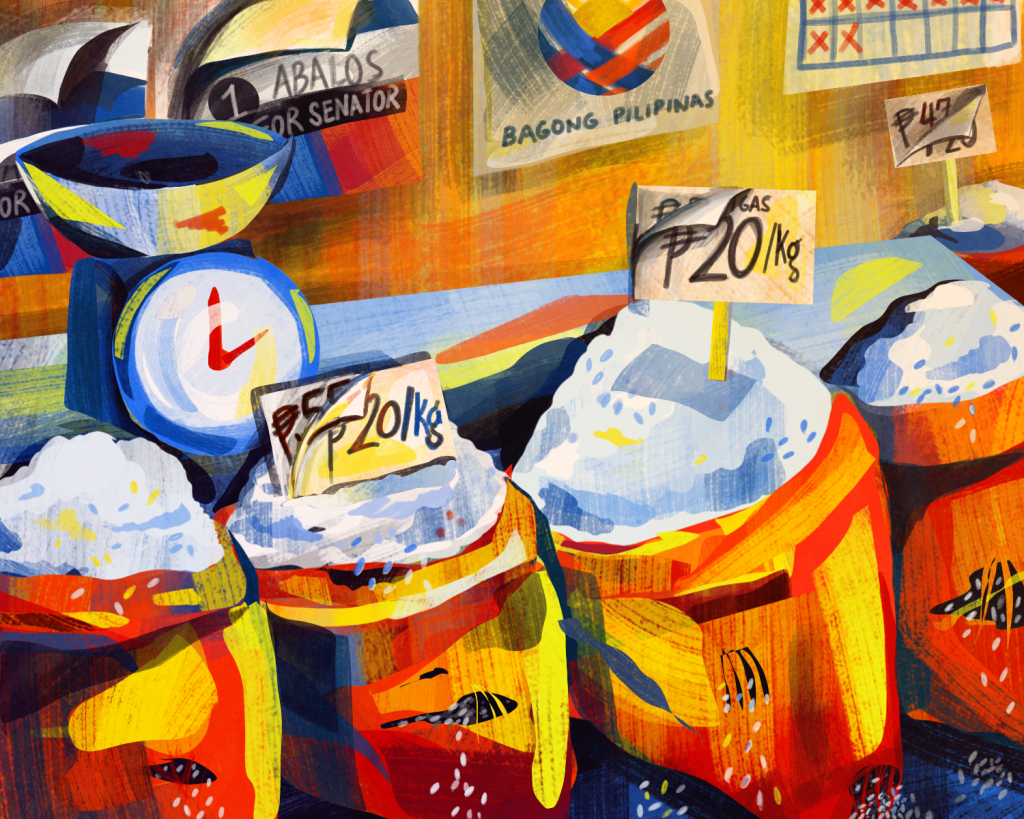Tags
When P20 Per Kilo Rice Acts as the Elite’s Shortcut to Harvest Political Support
Jullian Luchavez

Rice is a staple food for Filipinos, and with prices surging since 2023, populist politicians make rhetoric out of rice costs, targeting those most affected by inflation.
In the Philippines, rice is not just for eating—it’s for winning elections.
For years, politicians have made empty promises to reduce rice prices. President Ferdinand Marcos Jr. is no different, pledging P20 per kilo of rice at the start of his term. After struggling with the highest rice inflation since 2009, the president offered a temporary solution to his aspiration. KnP20, a program that distributes a subsidized P20 per kilo of rice to vulnerable groups, was finally implemented in Cebu.
Rice is a staple food for Filipinos, and with prices surging since 2023, populist politicians make rhetoric out of rice costs, targeting those most affected by inflation. Programs like KnP20 capitalize on promises to lower rice prices to attract voters, a practice rooted in patronage politics.
While it was set to be implemented in Visayas due to the island group’s high poverty rate, the program was first rolled out in Cebu City, which has a considerably lower poverty incidence than other areas in Visayas. Even with the ban on aid distribution before the midterm elections, the rollout began May 1. Although the Department of Agriculture suspended the sale a day after its launching, the program offered Marcos a chance to reclaim one of the most vote-rich cities following a drop in his approval ratings.
With elections approaching, Marcos’ ratings are crucial in boosting his senatorial slate, Alyansa Para sa Bagong Pilipinas, and ensuring his continuous capture of the upper chamber of Congress. But for the administration’s plan to succeed, senatorial candidates Francis Tolentino, Manny Pacquiao, and Benhur Abalos must improve their ranks despite public sentiment turning against Marcos coupled with the mutual rise of rival Sara Duterte’s approval ratings and her endorsed senators in the ranking.
But just as quickly as the elections will end, so will the P20 per kilo rice vanish after it exhausts the allocated P3.5–4.5 billion budget to subsidize P13 of the P33 per kilo market price—the perfect opportunity to give the illusion that the administration is handling food inflation in the country.
With only 900,886 Visayan families eligible, research group IBON Foundation estimates that the program will last only five months in the region, falling short of the DA’s projection of a December end date, and even further from Marcos’s aspiration to extend the program to all Filipinos nationwide. In the end, the program will be discarded along with the administration’s quick fix solutions to rice inflation, including the tariff cuts for imported rice that failed to lower prices and the P29 NFA rice, which fell flat among customers due to its use of aged stocks and restricted availability.
While these programs offer quick relief for Filipino families, steady, low rice prices will remain elusive without a long-term and sustainable plan to revitalize local rice production. Without genuine agrarian reform and agricultural development programs, both regular consumers victimized by empty election promises, and local farmers given minimal government support, will stew in hunger.
To end the cycle of empty rhetoric, farmers and other key sectors must gain genuine representation in the Senate, where they can champion the interests of the Filipinos who once placed their hopes in the hollow pledges of politicians.
https://phkule.org/article/1517/when-p20-per-kilo-rice-acts-as-the-elites-shortcut-to-harvest-political-support/Published Date: May 12, 2025






